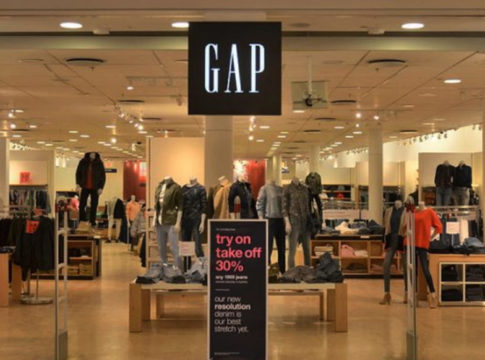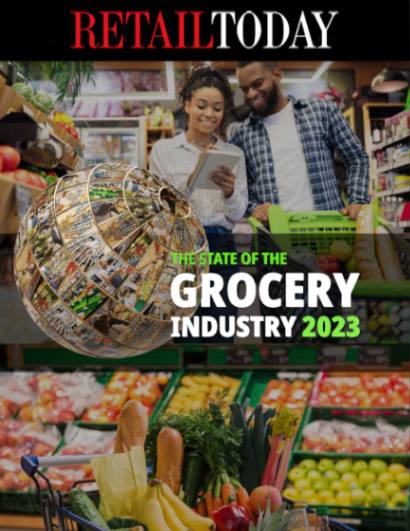Gap Inc. (NYSE: GPS), the largest specialty apparel company and second largest apparel e-commerce business in the U.S., which operates a portfolio of lifestyle brands, including Old Navy, Gap, Athleta and Banana Republic, reported its financial results for the first quarter of fiscal year 2020, ending May 2.
The Company’s first quarter results were impacted by the temporary closure of approximately 90% of its global store fleet starting on March 19. During the quarter, the Company enacted several measures to strengthen its cash position, as well as secured additional financing early in the second quarter, putting the Company in a solid financial position to weather the pandemic. The Company also leveraged its omni capabilities to continue to serve customer demand online through its scaled e-commerce platform.
“Our teams’ ability to pivot quickly and lean into our strong online business resulted in an encouraging 40% online sales growth in April. While net sales and stores sales continued to reflect material declines in May as a result of closures, we saw over 100% growth in online sales during the month,” said Sonia Syngal, President and CEO of Gap Inc. “This online momentum, enabled by new omni-capabilities that have expanded the way customers can shop with us, leaves us well-positioned to fuel our brands going forward.”
Syngal added, “Today we have more than 1,500 stores open in North America, ahead of plan, and as stay at home restrictions ease in many markets, we expect to have the vast majority of our North American stores re-opened in June. We are optimistic that the actions we’ve taken will provide a stable foundation as we navigate near-term uncertainty and refashion Gap Inc. for long-term growth.”
First Quarter 2020 Results
The Company noted first quarter results reflect the significant impacts of the global pandemic, including lost sales and corresponding merchandise margin from the temporary store closures, a non-cash impairment charge of $484 million related to the Company’s store assets and operating lease assets, as well as a $235 million non-cash inventory impairment charge.
The Company’s first quarter fiscal year 2020 net sales were down 43% year-over-year, as solid momentum in the first 35 days of the quarter was more than offset by meaningful deceleration in demand after temporary store closures beginning in mid-March. In response, the Company continued to serve customer demand online through its scaled e-commerce platform, which at over $4 billion in net sales in fiscal year 2019, represented about one quarter of the Company’s sales for that fiscal year. The Company’s first quarter 2020 online sales channel increased 13% compared to the first quarter fiscal year 2019, with the Company noting continued acceleration of online growth following the end of the quarter. The Company’s first quarter 2020 store sales decreased 61% compared to the first quarter fiscal 2019, driven by temporary store closures.
Additionally, the Company is not providing comparable sales results for the quarter because the metric is not meaningful as a result of temporary store closures in the period. Instead, the Company has provided net sales which consists of store sales and online sales, by brand. Store sales primarily include sales made at Company-operated and franchise stores. Online sales primarily include sales made through the Company’s online e-commerce channels, including ship-from-store sales, buy online pick-up in store sales, and order-in-store sales. First quarter net sales details appear in the tables at the end of this press release.
Net sales by brand for the first quarter 2020 compared to the first quarter 2019 were as follows:
- Old Navy Global: Net sales were down 42%; store sales were down 60% with online sales up 20%. Since the onset of the COVID-19 pandemic, Old Navy has seen a meaningful acceleration in its digital business. The Company noted it expects the off-mall, strip real estate that makes up approximately 75% of the fleet to be an advantage as customers return to stores and expects traffic in these locations to ramp up more quickly than other formats.
- Gap Global: Net sales were down 50%; store sales were down 64% with online sales down 5%. Prior to the onset of the pandemic, Gap brand performance continued to be pressured by inconsistent execution of product and marketing messages. However, the Company noted the brand did experience steady improvements in its online performance throughout the quarter, attributable to the Company’s strategy to migrate customers online as the brand’s fleet rationalization efforts continue.
- Banana Republic Global: Net sales were down 47%; store sales were down 61% with online sales down 2%. While the move to casual fashion during the stay-at-home requirements has benefited other brands in Gap Inc.’s portfolio, this shift left Banana Republic disadvantaged in its product mix. As a result, Banana Republic is taking aggressive action to adjust to consumer preferences and improve inventory mix.
- Athleta: Net sales were down 8%; store sales were down 50% with online sales up 49%. Customer response to Athleta was strong given the values-driven active and lifestyle space the brand participates in as well as the brand’s deep customer engagement through its powerful omni-channel model.
Gross margin was 12.7%, reflecting a $235 million non-cash inventory impairment charge, rent and occupancy deleverage associated with store closures, and increased promotional activity. As previously disclosed, beginning in April, the Company suspended rent payments for closed stores. While the Company remains in active and ongoing discussions with its landlords, it noted that first quarter gross margin reflects the cost of rent payments, which are being accrued for accounting purposes.
Operating loss was $1.2 billion. This reflects the decline in gross margin, as well as a non-cash impairment charge of $484 million related to the Company’s stores to reduce the carrying amount of the store assets and the corresponding operating lease assets to their fair values, which have dramatically declined as a result of the pandemic. The Company noted that as part of its ongoing specialty fleet optimization efforts, the Company has undertaken a strategic review of its real estate portfolio to further advance its long-term strategic priorities that include a smaller, healthier fleet, particularly as it relates to its Gap brand and Banana Republic specialty fleets.
The effective tax rate was 26.0% for the first quarter of fiscal year 2020. The first quarter effective tax rate reflects benefits associated with the enactment of the Coronavirus Aid, Relief, and Economic Security (CARES) Act, offset by the impact of the Company’s geographical mix of pre-tax earnings.
Diluted loss per share was $2.51.
Balance Sheet
The Company ended first quarter fiscal year 2020 with $2.2 billion in merchandise inventory, down about 1% year over year. Excluding Pack & Hold Inventory that is being held for introduction into the marketplace in the summer of 2021 and will be included in the second quarter ending inventory balance, the Company expects second quarter ending inventory to be down low to mid-single digits.
Short-term debt increased from $0 to $500 million, reflecting the Company’s full drawdown of its revolving credit facility. Long-term debt remained unchanged at $1.25 billion.
Early in the second quarter, the Company issued $2.250 billion of senior secured notes. A portion of the proceeds of the notes will be used to redeem the previously issued $1.250 billion unsecured notes due April 2021. The Company also repaid the outstanding $500 million borrowed under its prior revolving credit facility. In addition, the Company secured a $1.868 billion asset-based revolving credit facility that replaced its existing unsecured revolving credit facility. As of today’s earnings release, the $1.868 billion has not been accessed and remains available for Company use. The Company currently believes this new capital structure provides sufficient liquidity to navigate the COVID-19 pandemic.
The Company ended the quarter with 3,911 store locations in 42 countries, of which 3,313 were Company-operated.
Cash Flow
The Company ended first quarter fiscal year 2020 with $1.1 billion in cash, cash equivalents, and short-term investments compared to $1.7 billion at the beginning of the quarter. Cash flow performance was impacted by the sales decline caused by the pandemic, partially offset by $500 million borrowed during the quarter under the Company’s unsecured revolving credit facility.
The Company’s first quarter cash flow was negatively impacted by the temporary closure of its stores due to the COVID-19 pandemic, while still incurring the vast majority of its merchandise costs, store payroll and other operating expenses. Following North American store closures on March 19th, the Company executed several measures to strengthen its cash position including realigning inventory purchases to expected demand, reducing expenses, suspending rent payments, extending payment terms, reducing headcount across its corporate functions, reducing capital expenditures, deferring its previously declared first quarter dividend, suspending its quarterly cash dividend and share repurchases for the remainder of the fiscal year and securing new financing arrangements. Following these actions, the Company believes it is in a solid financial position to navigate through the continuing crisis and continue investing in its business.
Year-to-date free cash flow, defined as net cash from operating activities less purchases of property and equipment, was negative $1.1 billion compared with negative $136 million last year. Year-to-date capital expenditures were $122 million compared to $165 million last year. The variance in year-over-year free cash flow was due to the change in operating cash flow, caused by the sales decline as a result of the pandemic.
As part of the Company’s response to the COVID-19 pandemic, the Company plans to reduce its capital expenditures for the fiscal year by approximately 50%, and now expects capital spending to be approximately $300 million for fiscal year 2020, which includes about $30 million of expansion costs related to its Ohio distribution center.
Please see the reconciliation of free cash flow, a non-GAAP financial measure, in the tables at the end of this press release.
2020 Financial Outlook and Second Quarter Business Update
Beginning May 9, 2020 the Company started to reopen stores in select states and countries in accordance with official COVID-19 recommendations provided by the World Health Organization (WHO), Centers for Disease Control (CDC), Public Health Agency of Canada, and local government guidelines, as well as the Retail Industry Leaders Association (RILA) and in partnership with industry peers to implement a number of health and safety measures that will support its teams and customers with a safe and seamless shopping experience.
“While we are pleased that store traffic and productivity is exceeding expectations, particularly at Old Navy and Athleta, we continue to plan conservatively as significant uncertainty remains ahead.” said Katrina O’Connell, EVP and CFO Gap Inc. “We intend to lean into our best-in-class supply chain and advantaged omni-channel capabilities to respond as customer demand becomes clearer.”
Given the high level of uncertainty in the current environment, the Company is not providing fiscal year net sales or earnings outlooks at this time.





